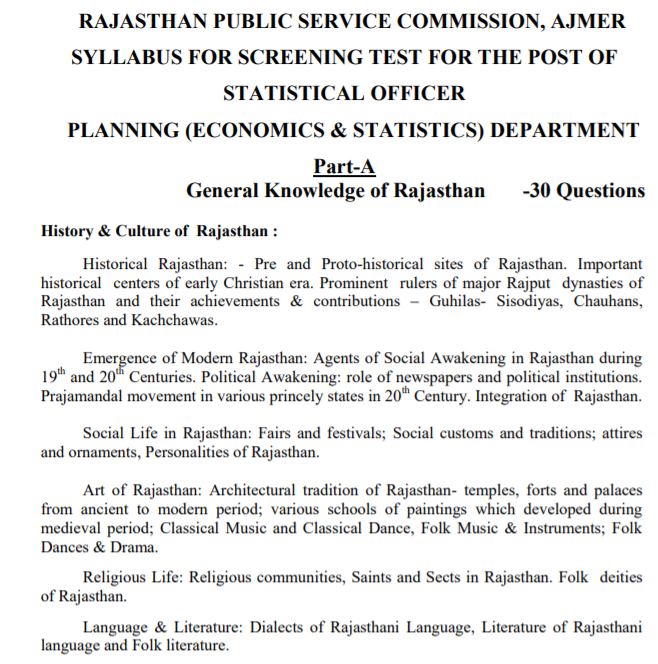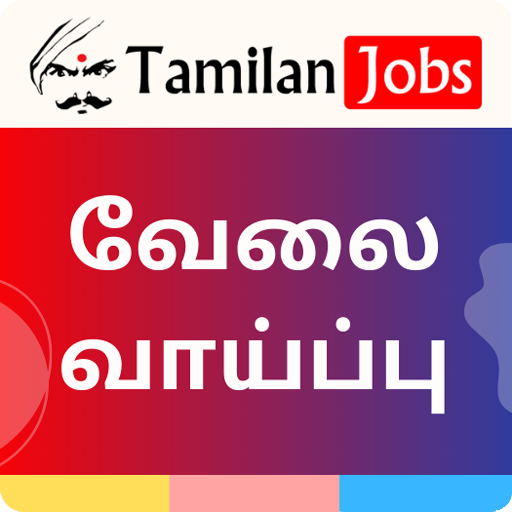RPSC Statistical Officer Syllabus 2021 PDF Download Here: The Rajasthan Public Service Commission has announced the Syllabus and Exam Pattern for Statistical Officer Post. There are 78 vacancies were announced for Statistical Officer Recruitment. As of now, The Rajasthan Public Service Commission, Ajmer has been uploaded the RPSC Statistical Officer Syllabus 2021 and Exam Pattern at the official website – https://rpsc.rajasthan.gov.in/. To save the time of applicants, We have attached the direct download link below.
RPSC Statistical Officer Syllabus 2021 – Details

| Check RPSC Statistical Officer Syllabus 2021 & Exam Pattern 2021 | |
| Organization | Rajasthan Public Service Commission (RPSC) |
| Post Name | Statistical Officer |
| Vacancies | 78 |
| Category | Syllabus |
| Exam Date | Announced Soon |
| Job Location | Rajasthan |
| Official website | rpsc.rajasthan.gov.in |
RPSC Statistical Officer Exam Pattern 2021
| Type of Question | Part | Maximum Marks | Number of Questions | Duration of Paper | Languages |
| Objective Type Paper | Part A – General Knowledge of Rajasthan | 150 | 30 | 2:30 Hours | Bilingual in English & Hindi |
| Part B – Statistics, Economics, and Mathematics | 120 | ||||
| Total | 150 | 150 | |||
RPSC Statistical Officer Syllabus 2021
Part-General Knowledge of Rajasthan
History & Culture of Rajasthan :
- Historical Rajasthan: – Pre and Proto-historical sites of Rajasthan. Important historical centers of the early Christian era. Prominent rulers of major Rajput dynasties of Rajasthan and their achievements & contributions – Guhilas- Sisodiyas, Chauhans, Rathores, and Kachchawas.
- The emergence of Modern Rajasthan: Agents of Social Awakening in Rajasthan during the 19th and 20th Centuries. Political Awakening: role of newspapers and political institutions. Prajamandal movement in various princely states in the 20th Century. Integration of Rajasthan.
- Social Life in Rajasthan: Fairs and festivals; Social customs and traditions; attires and ornaments, Personalities of Rajasthan.
- Art of Rajasthan: Architectural tradition of Rajasthan- temples, forts, and palaces from ancient to the modern period; various schools of paintings which developed during the medieval period; Classical Music and Classical Dance, Folk Music & Instruments; Folk Dances & Drama.
- Religious Life: Religious communities, Saints, and Sects in Rajasthan. Folk deities of Rajasthan.
- Language & Literature: Dialects of Rajasthani Language, Literature of Rajasthani language and Folk literature.
Geography of Rajasthan:
Major physiographic divisions of Rajasthan. Drainage characteristics. Weather conditions. Vegetation, forest, and Soil, Natural Resources, Minerals, livestock population of Rajasthan. Wildlife and its conservation. Environmental Conservation, Droughts, and Desertification, Major Irrigation Projects. Agricultural Crops and Problems. Population growth and Tribes of Rajasthan, Handicrafts, and Tourism. Development schemes in Rajasthan. Power resources with non-conventional energy sources.
PART-B:
Collection, Classification, Tabulation, and diagrammatic presentation of data. Measures of Central Tendency: Mean, Mode, Median, Harmonic mean. Geometric means, Properties, applications, merits, and demerits. Measures of Dispersion: Range, mean deviation, standard deviation, variance their applications, properties, merits, and demerits. Moments: Raw moments, central moments, Factorial moments. Skewness and Kurtosis: Various measures of Skewness and Kurtosis, their properties.
Correlation and Regression: Karl Pearson and rank correlation coefficients. Multiple and partial correlations (for three variables), Linear regression, fitting, regression coefficients, properties, the angle between two lines of regression.
Probability: Classical and Axiomatic approaches of probability, Conditional Probability, Bayes theorem, Random variables, and Mathematical expectation with applications.
Probability Distributions: Discrete distributions: Uniform, Poisson, exponential, rectangular, geometric, hypergeometric, power series distributions, properties, and applications. Continuous Distributions: Normal, uniform, Beta, Gamma. Exponential, Weibull, Logistic, Cauchy distributions, properties and applications, central limit theorem.
Sampling distributions: Chi-square, t, and F distribution (central and non-central), properties, and applications.
Multivariate Analysis: Multivariate Normal Distribution, Hotelling’s T2 and Discriminant Analysis, Wishart distribution and its properties.
Theory of Estimation: Point and Interval estimation, Properties of the estimator, Methods of Estimation- Least Square and Maximum Likelihood estimators and their properties. Crammer- Rao Inequality, Blackwell theorem, confidence intervals, and limits for large samples.
Testing of Hypothesis: Concept of Hypothesis, Types of error in testing, Critical Region and level of significance, Neyman Pearson Lemma and two-tailed tests based on small and large samples, likelihood ratio test.
Non-Parametric Tests: Run, Sign, Median, and Kolmogorov Smirnov one-sample test, Mann- Whitney- Wilcoxon U- test.
Design of Sample Survey: Sampling Unit, Sampling frame, Sampling fraction, Sampling with and without replacement, Population Parameter, and Sample estimator, efficiency, accuracy and precision, sampling and nonsampling errors, Simple random sampling, Probability proportion to Size with replacement, Sampling with varying probability and without replacement, stratified random sampling, systematic sampling, cluster sampling, multistage sampling, ratio and regression methods of estimation.
Design of Experiments: Analysis of variance for one-way and two-way classified data, Principles of Designs, Completely Randomised Designs, Randomised Block Designs, Latin Square Designs, 2n – factorial experiments, Split plot and Strip plot Design, BIBD, Complete and Partial confounding.
Time Series Analysis: Components, Measurements of Trend, Seasonal, Cyclical and irregular variations, Periodogram analysis.
Index Number: Uses, types, and limitations of index numbers, construction of index numbers, simple and weighted aggregated method, Simple and weighted average price relatives, Chain base index numbers, Base shifting, Splicing, and Deflating of Index numbers, Cost of Living Index numbers.
Vital Statistics: Collection of vital statistics- Measures of Mortality, Law of mortality, fitting of Makeham’s law, Fertility rates, life tables, Abridged life-table (King’s method), Population growth.
Statistical Organization of India: CSO, NSSO, National Income Statistics, Population Census, Agricultural Census, Livestock Census.
Micro Economics: Consumer Behaviour- Cardinal and Ordinal Approach, Concept of elasticity, Producer equilibrium, Price determination in Perfect competition, Monopoly Monopolistic Competition, Pareto optimal conditions.
Macro Economics: National Income and Methods of measuring national income, Consumption and Investment function, Money supply, High powered Money and Money multiplier Central and Commercial banks.
Public finance: Role of Government in organized society, Private Goods, Public goods, Merit goods, Market failure, Budgetary deficits, GST- Fiscal Sector reforms.
International Economics: Meaning and Components of Balance of payments, Trends in Exports and Imports, Composition of Trade, Recent Foreign Trade policy.
Economics of Growth and Development: Factors affecting growth. Poverty, inequality of income, Human Development Index, Sustainable development
Indian Economy: Agriculture reforms, Recent Industrial policy, Govt. schemes of unemployment and poverty alleviation. Impact of liberalization, Globalisation, and privatization on the Indian Economy. Recent Monetary and Fiscal Policy, NitiAayog, Covid 19- Impact on Indian Economy.
Algebra: Relation between roots and coefficients, repeated roots, elementary symmetric functions, Algebra of Matrices, Rank, and determinant of Matrices. Eigenvalues and Eigen Vectors.
Calculus: Limits, Continuity properties of continuous function in closed intervals, differentiability, mean value theorem, Taylor’s theorem, curvature, asymptotes, Partial differentiation, and its applications. Rectification, quadrature, volume, and surface of revolution.
Differential Equations: Linear and non-linear differential equation of first order, linear differential equation with constant coefficients, homogeneous differential equations. Partial differential equations of first and second order.
Complex Analysis: Analytic function, Cauchy Riemann equations, Cauchy’s theorem, Cauchy’s integral formulae, Power series, Laurent’s Series, Singularities. Beta- Gamma functions.
Special Functions and Integral Transforms: Hypergeometric functions, Legendre’s Polynomials, Bessel’s function, Recurrence relations, orthogonal properties and generating functions, Laplace transforms and inverse Laplace transforms.
Fundamentals of IT and Computer Applications: Basic knowledge of Word Processing Software, formatting, alignment, graphs, and charts, headers and footers, various tabs and options. Basics of Spreadsheet, Manipulation of cells, Formulas and Functions, Editing of Spread Sheet, Printing of Spread Sheet. Basics of Presentation Software, templates, wizards, slide show, building a presentation, various tabs, and options. Accounting software basics. Basic knowledge of the internet, internet security, types of cyber threats, digital signatures, secure seals, secure browsing. Digital payments and platforms, online banking, online payment modes, mobile wallets, E-commerce basics. GIS basics, e-governance in Rajasthan.
RPSC Statistical Officer Syllabus 2021 – Click Here (Available Now) ![]()

